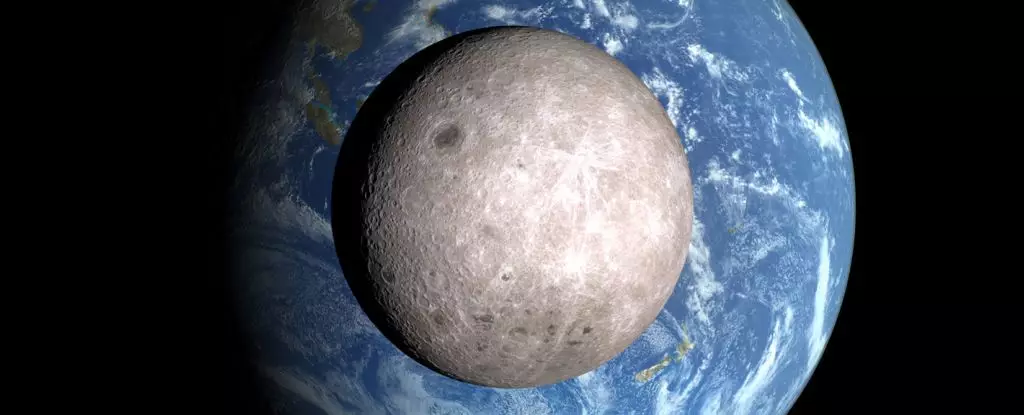The Moon, our steadfast celestial neighbor, holds not just man-made myths and legends, but also profound scientific mysteries, particularly regarding its water distribution. Analysis of lunar materials from the far side of the Moon has revealed a shocking disparity in water content when compared to the side that perpetually faces Earth. This revelation, while intriguing, raises more questions than answers about the Moon’s formation and geological evolution.
The stark contrast between the Moon’s two hemispheres is incredibly striking. The near side, resplendent with large, flat basaltic plains known as maria, tells a tale of intense volcanic activity that filled its surface millions of years ago. In contrast, the far side seems to bear the scars of a history marked by relentless bombardment, showing a landscape riddled with craters and seemingly devoid of volcanic features. This unevenness invites an examination of the Moon’s interior composition, which may hold the key to understanding its asymmetric exterior.
The Giant Impact Theory: A Historical Perspective
Current scientific consensus leans towards a cataclysmic past for the Moon’s formation. Most agree that a collision with a Mars-sized planetesimal, dubbed ‘Theia,’ approximately 4.5 billion years ago, kicked off the Moon’s evolutionary saga. The debris from this colossal impact cooled and eventually coalesced into the Moon that we observe today. However, this simplified narrative glosses over the complexities of what transpired in the Moon’s crust and mantle afterward.
Despite this foundational understanding, presenting the Moon’s history as a straightforward consequence of a single collision could be naïve. It paints a misleadingly simplistic image of our cosmic companion. For instance, while the near side was likely kept warmer during the post-formation cooling period due to its proximity to Earth, one must wonder if there are deeper geological processes at play that further influenced water distribution across the Moon.
The Groundbreaking Findings of Chang’e-6
The recent Chang’e-6 mission was not just a monumental leap for China’s space exploration efforts; it was humanity’s ticket to deciphering the Moon’s enigmatic composition. With the first samples from the far side, scientists have begun to scrutinize the Moon’s chemical makeup, leading to eye-opening conclusions about water scarcity. The samples revealed a mere 1 to 1.5 micrograms of water per gram of rock in the South Pole-Aitken Basin—a stark contrast to the water-rich minerals found on the near side.
This disheartening discovery indicates a climatic not just geological but also an asymmetrical evolution. It implies that the violent impacts during the Moon’s formative years may have played a dual role: while some materials were shoved toward the near side, others remained stranded on the far side, deprived of the liquid that life, as we know it, depends on.
Exploring the Implications
The implications of these findings are profound. For one, the disparity in water availability may stymie future human endeavors on the Moon. Advocates for lunar colonization often cite the Moon as an ideal destination for establishing a human presence beyond Earth, but understanding its resource distribution is crucial. If water reserves are indeed bountiful only on one hemisphere, the logistics of establishing habitable colonies would necessitate extensive planning, complicating any ambitious interplanetary initiatives.
Moreover, this understanding reshapes our perception of the Moon as a resource. It cannot simply be treated as an inert mass waiting to be exploited. Acknowledging its asymmetrical composition underscores the need for a more nuanced approach to lunar exploration and colonization—one that is respectful of its complexity and potential fragility.
The Ethical Quandaries of Lunar Exploration
As we stand on the brink of further lunar exploration, we must grapple with ethical questions that spring from these findings. Are we prepared to treat the Moon not merely as real estate but as a celestial body with its own history and identity? Our approach must incorporate detailed ecological considerations that respect the Moon’s geological diversity.
These revelations compel us to advocate for responsible exploration strategies. Rather than rushing to claim resources, we should prioritize comprehensive scientific studies that build upon the foundation laid by missions like Chang’e-6. With a more profound understanding of the Moon, we can ensure that our ambitious pursuits in space are conducted sustainably, acknowledging the ancient narrative written in its surface.
As we continue to piece together the Moon’s history, let’s ensure our actions speak with the wisdom that its past demands. Only by doing so can we embrace the Moon’s secrets and navigate the complexities of our shared universe with reverence and responsibility.

Leave a Reply